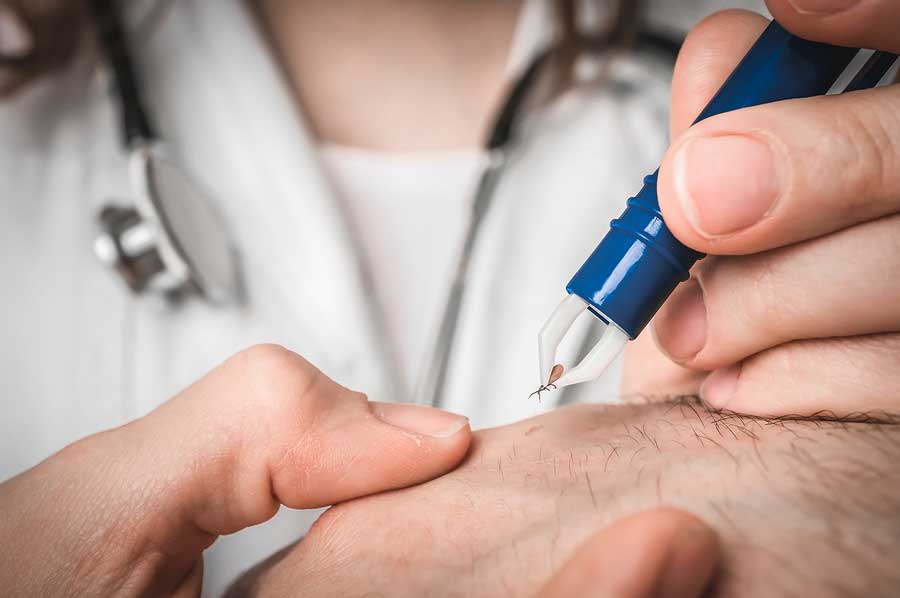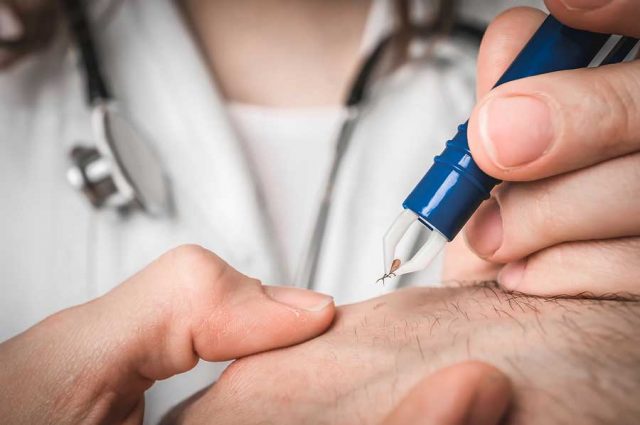
Lyme disease is bacterial disease. There are four species of bacteria that cause this disease, separated geographically- Borrelia burgdorferi and Borrelia mayonii in the United States; Borrelia afzelii and Borrelia garinii in Europe and Asia. It is spread via infected ticks that transmit the bacteria into the blood.
Watch Out for Ticks
Only one species of tick is responsible for spreading Lyme disease- the black-legged tick, otherwise known as a deer tick. It is most commonly found throughout the mid-west and northeast United States. Young specimens are no bigger than a poppy seed, so they can be hard to spot even if you are bitten.
The best way to prevent Lyme disease is to avoid being bitten by a tick. Ticks thrive in tall grasslands or wooded areas. It is a good idea to wear long sleeves and pants when going outside if you are exploring the wilderness or live in a rural area. You can use insect repellent for extra protection. You can also tick-proof your yard by clearing brush and mowing regularly.
If you’ve been outside, make a habit out of checking yourself for ticks once you’re back in your home. When removing ticks, be sure that the head isn’t left behind. This is best done with tweezers or a tick scoop. The longer the tick is attached, the more likely you are to contract Lyme disease, so check often- infection is unlikely if the tick is attached for less than 36 hours.
Symptom Stages
Symptoms are gradual and usually appear in stages, which can sometimes overlap. They are separated into early and late stage symptoms.
Early Stage Symptoms:
One of the first things to keep an eye out for if you find a tick is a red ring that can appear around the bite, although it can be a delayed reaction up to 30 days later. This rash can expand up to 12 inches in bulls eye pattern over the course of days. It usually isn’t itchy or painful, just warm to the touch. This rash is called erythema migrans. However, it does not necessarily appear for everyone who has been infected with Lyme disease. You might also notice fatigue, chills, body aches, headaches or swollen lymph nodes. Sometimes Lyme disease can be confused with anemia or the flu in these early stages, causing it to go untreated for long periods of time. Diagnosis can be confirmed through blood testing.
Late Stage Symptoms:
These symptoms can appear between a few weeks to a few months from the date of infection. The erythema migrans may spread to other parts of the body. Bouts of intense joint pain are common, usually concentrated at the knees, but can jump from joint to joint. This is usually accompanied by swelling of the affected joints. If untreated, Lyme disease can also progress to neurological problems, sometimes even years after infection. These problems include impaired muscle movement, limb weakness, inflammation of the membrane surrounding the brain (meningitis) or temporary paralysis of one side of the face.
Treatment Options
Lyme disease is often difficult to diagnose, which sometimes allows it to reach the point of late stage or chronic progression. For this reason, try to ask for blood testing if you even have a slight suspicion you may be infected.
Once diagnosed, treatment is for that of an acute infection and should be individualized based on the symptoms, their severity, the presence of any other tick borne co-infections and the patient’s response to treatment over time. However, if caught early, an aggressive course of antibiotic treatment is usually prescribed. “High risk” bites, like those from endemic areas or situations where the tick was attached for more than 48 hours, should probably receive slightly longer courses of antibiotics.
Chronic Possibilities
If left untreated, Lyme disease can take the form of chronic ailments that stay with you for life. The usual suspects are:
- chronic join inflammation, otherwise known as Lyme arthritis
- heart rhythm irregularities,
- cognitive defects like impaired memory or
- neurological symptoms like facial palsy.
Living with Lyme disease long enough can reveal additional symptoms like hair loss, sensitivity to hot and cold, chills, canker sores and increased thirst. You may also become more susceptible to herpes simplex virus, shingles and bouts of the flu.
Life with Lyme Disease
Regardless of how the disease manifests chronically, physicians are split between what is causing the symptoms. Some say that it is autoimmune, and call it “post-Lyme syndrome”. Some believe that the symptoms indicate that the bacterial infection is still active. There is currently no test that can confirm whether or not the infection has been eradicated from the blood.
It is helpful to find a Lyme literate medical doctor (LLMD) to work with going forward, and join a forum or community of others with Lyme disease. That way you can address your symptoms as they come, and crowd-source ideas and resources. The support of other people who know exactly what you are going through can also be invaluable.
Did you find this article helpful? Join us at HealingWell for support and information about Lyme Disease. Connect and share with others like you.




